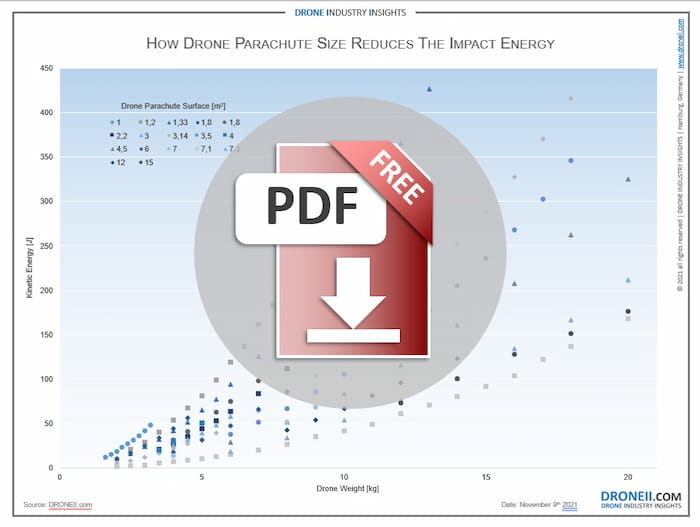Why Use Drone Parachutes?
We recently carried out a brief poll about drone parachutes. Based on the responses, roughly 1/4 of drone users have used or continue to use a parachute for their drone. Yet around 44% of respondents had never considered using one before. That same poll also suggests that 31% consider it impractical or expensive, but the higher amount of people who hadn’t even considered using one suggests that there may be a lack of awareness about the benefits and need for drone parachutes. All of this leads to the natural question: why should someone use a drone parachute in the first place?
Drone parachutes slow down the fall and therefore reduce the impact energy of the drone against anything below it. The larger the parachute the lower the impact energy. However, the heavier a drone becomes, the harder it gets to slow down its fall. In the infographic below, you can see the kinetic energy curves of actual drone parachutes available today. An exponential increase in impact energy is evident as the drone weight increases. So why is it imperative to slow down the fall of a drone and why does choosing the right parachute size matter so much?
Drone parachutes represent a last line of defense
In case of an emergency, when everything else to keep the drone in the air has failed, drone parachutes are crucial. Naturally, no one wants a drone to malfunction or completely fail in mid-air. However, this is something that is entirely out of the pilot’s control (assuming they have carried out regular checks between missions). Moreover, in a worst-case scenario where a drone might be in freefall above a crowd of people, it is clear that a pilot can’t retrospectively put on a parachute that wasn’t there in the first place. So it was either there to begin with, or it was not. And these are the top 3 reasons why drone operators should still prepare for such a worst-case scenario:
Protect drones, equipment and cargo
The first reason is perhaps the most evident one. Commercial drones are a worthwhile investment that nevertheless carry a financial cost of thousands of dollars. That is why it is important to protect them and ensure an accident doesn’t translate into the need for a new drone. A parachute may seem expensive, but it is likely cheaper than buying a whole new drone, especially if a mid-air failure happens more than once and given that drone parachutes are reusable.
Additionally, commercial drones are often equipped with expensive sensors, lenses or other cargo. LiDAR sensors can cost between US$65,000-100,000, and cargo can vary from expensive items to items for medical emergencies. A parachute protects all of these things by reducing the falling speed of the drone, so it is important to research all the available drone parachutes in order to find the one that fits the weight of the drone and cargo.
Drone parachutes also protect people and infrastructures
In comparison to a freefall, a parachute reduces the impact energy exponentially. This is rather important not only for the drone and its cargo, but also for any bystander that might happen to be below the drone, or any sensitive structures that could be damaged. Damages to people or infrastructure can be costly whether it be for reparations, injury, or even lawsuits for damages in some countries. And the slower the falling speed, the less damage that can occur.
If we return to the infographic above, we see that a drone that weights 10kg will still have a kinetic energy of 250 joules (J) if it uses a parachute with a surface area of 1.33 square meters, but it will be slowed down to about 100 joules with a parachute of 3.5 square meters of surface area. In this regard, the French Civil Aviation Authority (DGAC in French) evaluated an impact energy below 69 Joules as feasible. In the USA, there is a need for less than 174 Joules for type certificate flight hour reduction. Currently, however, exceeding this value has no regulatory or legal consequences.
Regulations suggest drone parachutes may become mandatory
Perhaps the best long-term reason for drone parachutes relates to regulation. The drone parachute industry currently sees its biggest potential in the drone delivery and cargo market. This market segment is the most likely to operate in BVLOS conditions and/or over people in urban areas. Consequently, parachute systems will be required for these types of operations, especially once they become more routine within the next years. Not surprisingly, the reason for these regulations and the requirement for drone parachutes in BVLOS and operations over people stems precisely from the need to protect people in case of a worst-case-scenario of mid-air failure. So once these regulations take effect, it is likely that drone parachutes will be not only more widespread but also mandatory.
In conclusion, though only a small portion of drone operators regularly use a parachute, it seems that a large majority are neither against them, nor in favor, but rather simply unaware of their benefits. Aside from the obvious benefit of protecting the drone and its equipment and cargo, there is a lot to be said about the way they can protect people and infrastructures below. Moreover, the increased level of regulation will certainly allow for more drone operations to take place, yet it will also likely require drone parachutes in certain types of operations. To learn more about the various players in the Drone Parachute Market as well as their solutions, check out the full Drone Parachute Report and download a free sample here.
Download our FREE Infographic: Drone Parachutes Impact Energy
This infographic “Drone Parachutes Impact Energy” plots several drone parachutes available and how they slow down descent of drones based on weight classes.

Before working with drones, Ed acquired vast experience in Communications and Diplomacy. He holds a Master’s in International Relations, Bachelor’s in Economics & Philosophy, and has lived in 7 countries.




